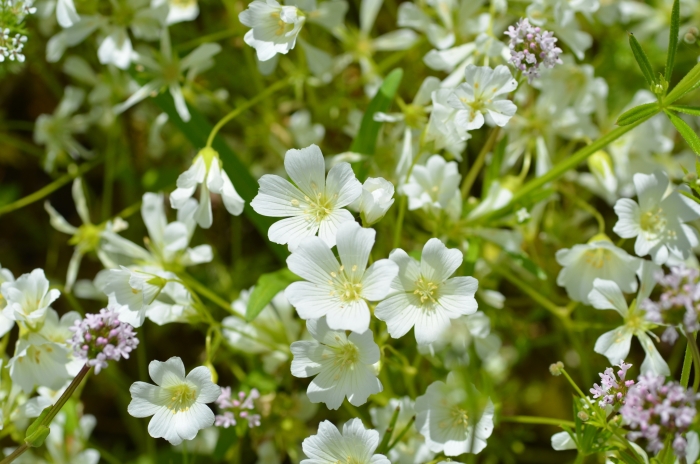White Meadowfoam
(Limnanthes alba)
White Meadowfoam (Limnanthes alba)
/
/

Lori Brandt Dudzik
CC BY-SA 4.0
Image By:
Lori Brandt Dudzik
Recorded By:
Copyright:
CC BY-SA 4.0
Copyright Notice:
Photo by: Lori Brandt Dudzik | License Type: CC BY-SA 4.0 | License URL: http://creativecommons.org/licenses/by-sa/4.0/ | Rights Holder: Lori Brandt Dudzik | Publisher: iNaturalist | Date Created: 2022-04-29T10:51:46-07:00 |
























Estimated Native Range
Summary
Limnanthes alba, commonly known as White Meadowfoam, is an annual herb that is native to vernal pools, wet meadows, and seasonally moist, grassy areas in California and Oregon. It typically grows up to 12 inches in height and produces a profusion of white, cup-shaped flowers with yellow centers and petals ranging from 0.5 to 1 inch long during the spring season. The flowers are modest in size but can be quite showy when in large numbers. White Meadowfoam has a sprawling habit and can form dense mats in its native habitat.
White Meadowfoam is valued for its seeds, which are a source of meadowfoam seed oil, highly regarded for its exceptional oxidative stability and used in a variety of cosmetics and lubricants. The plant is also appreciated for its ability to thrive in wet, poorly drained soils, making it suitable for rain gardens and restoration projects where seasonal wet conditions prevail. It is often used in wildflower mixes for its attractive flowers and ability to support pollinators. In cultivation, White Meadowfoam requires consistent moisture and does best in full sun to part shade. It is generally easy to grow from seed and can be direct-sown in fall or spring. While it is not typically troubled by pests, it is susceptible to the Botrytis cinerea fungus, which can cause significant damage to crops under humid conditions. Care should be taken to provide good air circulation to minimize disease risk.CC BY-SA 4.0
White Meadowfoam is valued for its seeds, which are a source of meadowfoam seed oil, highly regarded for its exceptional oxidative stability and used in a variety of cosmetics and lubricants. The plant is also appreciated for its ability to thrive in wet, poorly drained soils, making it suitable for rain gardens and restoration projects where seasonal wet conditions prevail. It is often used in wildflower mixes for its attractive flowers and ability to support pollinators. In cultivation, White Meadowfoam requires consistent moisture and does best in full sun to part shade. It is generally easy to grow from seed and can be direct-sown in fall or spring. While it is not typically troubled by pests, it is susceptible to the Botrytis cinerea fungus, which can cause significant damage to crops under humid conditions. Care should be taken to provide good air circulation to minimize disease risk.CC BY-SA 4.0
Plant Description
- Plant Type: Herb
- Height: 0.25-0.5 feet
- Width: 0.5-1 feet
- Growth Rate: Moderate
- Flower Color: White
- Flowering Season: Spring
- Leaf Retention: Deciduous
Growth Requirements
- Sun: Full Sun, Part Shade
- Water: Medium
- Drainage: Medium, Slow
Common Uses
Bee Garden, Bird Garden, Butterfly Garden, Low Maintenance
Natural Habitat
Native to vernal pools, wet meadows, and seasonally moist, grassy areas in California and Oregon
Other Names
Common Names: Poached egg plant, White Meadowfoam
Scientific Names: , Limnanthes alba, Limnanthes alba, Limnanthes alba var. alba, Limnanthus alba,
GBIF Accepted Name: